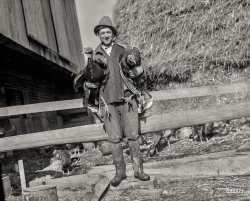
MAY CONTAIN NUTS

Search Shorpy
SHORPY ART

Framed or unframed, desk size to sofa size, printed by us in Arizona and Alabama since 2007. Explore now.
Join and Share
Ad-Free Shorpy
Shorpy is funded by you. Patreon contributors get an ad-free experience.
Learn more.

Recent comments
- Pinstripes in the Tower
- Sound enhancement
- 3438 in '38
- Second Career
- Their days are numbered
- Only the Sensor
- Train control mechanism
- Rarest of the Rare?? & Classy 3400 Class
- Control Mechanism
- Those standpipes
- Wrenches
- International D-40 I believe
- Job prospects
- You had me at Train
- Land of the free
- Broad-Exchange Bldg
- Parking innovation
- The old block
- "Peck turned a sweet propeller"
- National Bank Building
- Notch shot
- Straight ahead (right, left, left, right)
- Ship lifespans
- New service
- You Say Station, I Say Potato ...
- Iron Age
- Thank you, Cornelius Vanderbilt
- Grand Central Terminal
- If they made a movie of it
- Obsolete by then.
Member Photos
The Shorpy
Printporium
Printporium
Search Shorpy
Search results -- 30 results per page
- Durward Nickerson: 1914
- ... of my husband, Jack Graham Weaver. Durward died in 1937 in Bernalillo County, New Mexico, at the age of 42.
Patsy Weaver
... Posted by Dave - 08/26/2011 - 3:49pm -
![Durward Nickerson: 1914 "Durward Nickerson, Western Union messenger #55. Birmingham, Alabama. 18 years old. Lives in Bessemer, R.F.D. #1. Saturday night, Sept. 26, 1914, he took investigator through the old Red Light on Avenue A, pointed out the various resorts, told about the inmates he has known there. Only a half dozen of them were open now. Durward has put in two years in messenger work and shows the results of temptations open to him. He has recently returned from a hobo trip through 25 states. He was not inclined to tell much about the shady side of messenger work, but one could easily see that he has been through much that he might have avoided in a profitable kind of work." View full size. Photo by Lewis Wickes Hine.
Lewis HineLewis Wickes Hine: Photographer, social reformer and busybody party-pooper extraordinaire.
Shady workI had no idea messenger work could be so seedy.
LisaHe looks old beyond his years. Great idea for a blog. I subscribed to your feed.
Durward NickersonDurward M. Nickerson was the son of Otis Graham Nickerson & Hattie E. Shepard, great-grandparents of my husband, Jack Graham Weaver. Durward died in 1937 in Bernalillo County, New Mexico, at the age of 42.
Patsy Weaver
[Oh my. What happened? Did he leave a family? Thanks for the info. He seems like a dashing young man. - Dave]
(The Gallery, Birmingham, Lewis Hine)](https://www.shorpy.com/files/images/03932u_1.thumbnail.jpg)
- Fly Me to the Moon: 1942
- ...
Tired The wheel and hubcap are from a 1937 Ford V8 equipped vehicle, and the hood seems to be from a 1928 Chevrolet. ... Posted by Dave - 08/06/2014 - 12:34pm -
![Fly Me to the Moon: 1942 May 1942. Parris Island, South Carolina. "Marine Corps glider detachment training camp. A glider winch." Medium format nitrate negative from photos by by Pat Terry and Alfred Palmer for the Office of War Information. View full size.
Kinda basicWell,
- Engine - check!
- Drive shaft - check!
- Cable drum - check!
- Power lever - can't see it, but I guess it will be a pedal - check!
- Safety cage - a very strong must for a winch, those cables are like band saws if they get out of control - check!
- Brake - can't see that, either, but I would guess another pedal - check!
- Cable guillotine - can't see that either, but it is an indispensable safety item.
Well, what is that steeringwheelgood for? My first guess would be a manual cable spooling guide. To reduce wear and tear and cable salad potential.
And voila, you got a glider winch.
More modern incarnations can be found galore under http://www.skylaunch.de/album/
Wrong WayUnless it pulls gliders from behind the guy's back, it's facing the wrong way. The gliders would be taking off downwind, making them uncontrollable.
The cage keeps the end of the cable with a little parachute attached from falling on him. The glider releases it pretty much right overhead.
[I suspect they know what they're doing. Below, two more views. - Dave]
TiredThe wheel and hubcap are from a 1937 Ford V8 equipped vehicle, and the hood seems to be from a 1928 Chevrolet.
Gliders in GermanyI had never seen gliders launched this way until I was serving in the Army in Giessen, Germany in 1965-1967. The website in the post by StefanJ, under the "G" tab, will get you to the Giessen glider club's website - they used winches to launch their gliders back then, and apparently still do.
(The Gallery, Alfred Palmer, Aviation, WW2)](https://www.shorpy.com/files/images/SHORPY-8d20782u1.thumbnail.jpg)
- Weed Hardware: 1938
- ... else did- I enlarged the photo to identify the car as a 1937 Ford Cabriolet rumble seat convertible. Very rare and desirable car today. ... Posted by Dave - 12/17/2016 - 5:23pm -
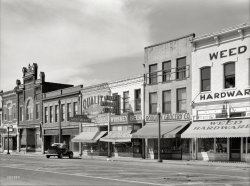
- Tex Williams: 1953
- ... guitars. I have an O-17 (given to my mother, new, in 1937)which I have played (not well) most all my life, And, gentlemen, it just ... Posted by Dave - 12/07/2015 - 3:28pm -
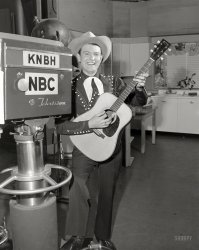
- Ye Old Witch House: 1901
- ...
Red Raven (S)plits From a 1937 Life Magazine ad:
"Red Raven Splits Laxative Water. For the morning ... Posted by Dave - 10/25/2012 - 10:37am -
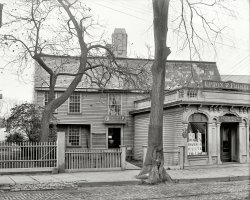
- Curb Service: 1940
- ... two-door sedan, 1935 Dodge, 1936 Ford, and far right, a 1937 Oldsmobile convertible, complete with fog lights, cowl mounted spotlights, ... Posted by Dave - 08/28/2018 - 11:03am -
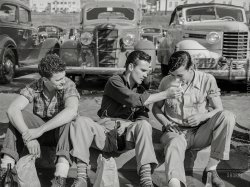
- Small-Mart: 1938
- ... The houses looked like this when they were built in 1937.
At one time there were apparently photographs from 2005-2006 of what ... Posted by Dave - 05/31/2015 - 11:28am -
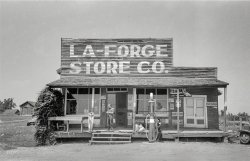
- Smith Garage: 1920
- ... the Coaches for the Coronation of King George VI in 1937, I would have absolutely believed it.
Pecking order From left to ... Posted by Dave - 09/14/2011 - 5:37pm -
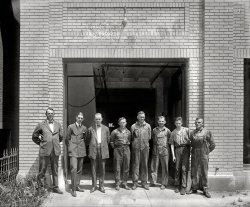
- North to the Future: 1942
- ... served at Fort Wainwright after having moved to Alaska in 1937. I bet he had some experiences like this, and you could always count on ... Posted by Dave - 10/15/2017 - 11:36am -
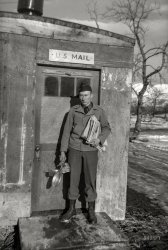
- Tidy That Tenement!
- A 1937 Works Progress Administration/Federal Art Project poster asking New ... Posted by Dave - 12/09/2007 - 9:52pm -

- Lesser Newark: 1939
- ...
Buick Limited? That looks like a 1937 Buick Limited on the street off to the right. Sure does not fit in that ... Posted by Dave - 11/30/2017 - 4:00pm -
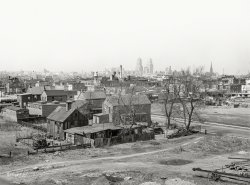
- Get Happy: 1925
- ... in the Washington-Baltimore area in the '20s and '30s. In 1937 they played at one of Franklin Roosevelt's inaugural balls. His main ... Posted by Dave - 09/30/2011 - 8:49pm -
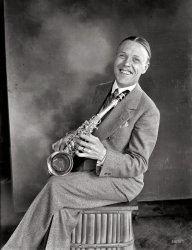
- Major Medical: 1920
- ... major in the U.S. Army. Stimson retired from the Army in 1937 and then served as president of the American Nurses Association from 1938 ... Posted by Dave - 08/28/2012 - 5:58pm -
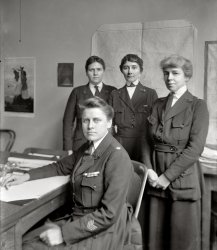
- The Three Amigos: 1908
- ... visit to Eureka in 1908), was born in 1899 and died in 1937 at the Gayle mill, also in Chester. That photo is available on the Lewis ... Posted by Dave - 09/07/2011 - 8:37pm -
![The Three Amigos: 1908 November 29, 1908. Boys working in the Eureka Cotton Mills at Chester, South Carolina. Rob Dover (tallest boy) has been in mill eight or nine years. Melvin Reilly (middle) in mill one year. Boyd McKowan is about 15 years old. Been in mill five years. Witness Sara R. Hine. View full size. Photo by Lewis Wickes Hine.
Found themSome records for Robert Dover:
#1 - b. 10 Nov 1894, d. Mar 1981 York, SC
#2 - b. 08 Mar 1893, d. Feb 1958 location unknown
Both had SS# issued in South Carolina.
If I change Boyd's last name to McGowen (k to g and a to e) I find:
b. 12 Aug 1896, d. Jun 1971 Michigan, SS issued in Michigan.
[Good work! Shorpy salutes you. - Dave]
Rob Dover and Boyd McKowanRob Dover and Boyd McKowan turned up nothing in a SSDI search result. However, I got four hits on Melvin Reilly. Seems like Melvin is a unique name. Three out of four records may match the date of this picture.
#1 - b.17 Aug 1899 d.Dec 1972 Pittsburgh
#2 - b. 7 Aug 1901 d.Jul 1980 Huron, SD
#3 - b.15 Mar 1897 d.Jan 1963 New Jersey
[Good work! Maybe Boyd's last name was really McGowan. - Dave]
Rob DoverActually, Robert (Rob Dover) died in 1958. This is the correct reference for him. He was my great great uncle. He worked for Springs Industries his entire life.
Also, his younger brother, John Washington Dover (known as Wash and Washey in the Lewis Hine picture from the same visit to Eureka in 1908), was born in 1899 and died in 1937 at the Gayle mill, also in Chester. That photo is available on the Lewis Hine descendants site.
Also, Lewis appeared not familiar with Southern pronunciations of traditional Scottish names. Boyd McKowan's name should be spelled McKeown. His descendants also still live around Chester.
Boyd McKeownThanks to the spelling suggestion from John Robinson, from the SSDI we find:
Boyd McKeown
born: 14 Jul 1892
died: Mar 1967
last residence: Great Falls, Chester, SC
state of SSN issue: South Carolina
(The Gallery, Kids, Lewis Hine)](https://www.shorpy.com/files/images/01457uu.thumbnail.jpg)
- Seafood City: 1943
- ... third in a clam-eating tournament on Block Island in 1937 by eating 84 cherrystone clams.
Re: Gordon's work will endure ... Posted by Dave - 06/13/2012 - 8:19am -
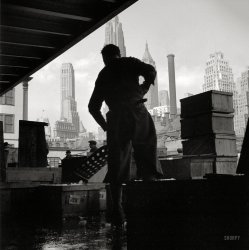
- Night Life: 1942
- ... and his orchestra were the house band at the DeLisa from 1937 to 1958, with a a brief pause between 1945-47. He did a fair bit of ... Posted by Dave - 12/03/2014 - 1:42pm -
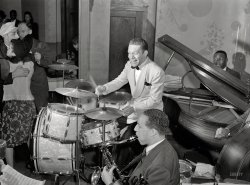
- Swamp Dwellers: 1939
- ... View full size.
To kill for today. That 1937 Chevrolet 5 window coupe at the lower left is a favorite among antique ... Posted by Dave - 01/29/2018 - 3:03pm -
![Swamp Dwellers: 1939 July 1939. Washington, D.C. "Pennsylvania Avenue at 14th Street N.W." Photo by David Moffat Myers for the Farm Security Administration. View full size.
To kill for today.That 1937 Chevrolet 5 window coupe at the lower left is a favorite among antique auto buffs today.
Civil EngineeringThe rule for sidewalks in grassy areas is leave them out and put them in later where the grass shows people are taking shortcuts.
I count 9 WindowsCan someone please explain how that term came to be? I see the windshield is cut in 2, you have 2 smokers glass, 2 roll ups, 2 deco-views, and the 1 rear glass panel = 5? I love the car, but maybe I don't understand the criteria.
[Windshield isn't counted; side windows are the full openings separated by body pillars, whether or not there are vents in addition to the roll-ups. So this car has 4 side windows and one rear window (aka “backlight”). -tterrace]
I once was lost, but now am foundIt took me a while to figure out exactly where this picture was taken but finally got it. The grassy area in the foreground is now Pershing Park. Across the street is the corner of the Willard Hotel . Looking further up 14th Street and on the right hand side is the National Press Building. The street entering from the right, in front of Whelans Drugs, is E Street. Freedom Plaza is now located between E and Pennsylvania. Wish I knew what the stone fronted building was on the right side of the picture. Last I knew there was a multi-story parking garage there.
[That's the old Washington Post building at 1339 E Street. Also seen here. - Dave] Thank you Dave. You and tterrace never fail to amaze me with the scope of your information.
Remembrance, indeedWe've seen this corner before. The low building at center here occupies the former home of the National Remembrance Shop ("Ask Mr. Foster"), seen in this 1924 photo.
(The Gallery, Cars, Trucks, Buses, D.C., David Myers, Streetcars)](https://www.shorpy.com/files/images/SHORPY-8b37581a.thumbnail.jpg)
- Round House: 1943
- ... as spats). He added the second "a" himself in 1937, supposedly at the request of his wife and daughters.
Lack of uniform ... Posted by Dave - 03/31/2014 - 7:31am -
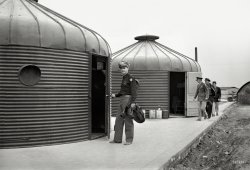
- Dream Catcher: 1938
- June 1938. "This farm was abandoned in 1937. Near Dalhart, Texas, Coldwater District." Photo by Dorothea Lange for the ... Posted by Dave - 02/07/2017 - 5:56pm -
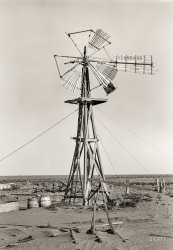
- I Was a Secretary for the FBI
- Washington, D.C., circa 1937. "Federal Bureau of Investigation. Miss Helen Gandy, secretary to J. Edgar ... Posted by Dave - 07/24/2013 - 1:36pm -
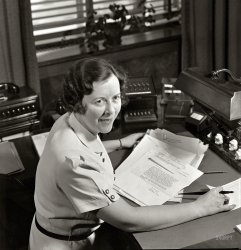
- Sugar and Spice: 1943
- ... line with the Mexicana decal. This line debuted in 1937 and quickly became very popular. Seems fitting for it to be found in a ... Posted by Dave - 03/11/2014 - 2:10pm -
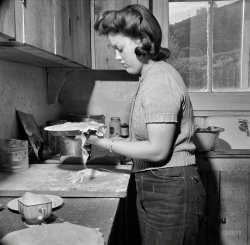
- Keep a Light On: 1940
- ... Administration. View full size.
Truck ID 1937 Ford
(I bet Tom Bodett would love this pic)
"Photographer of ... Posted by Dave - 01/03/2020 - 7:54pm -
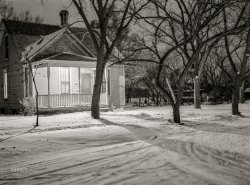
- Sawdust Memories: 1939
- ... Levis Our subject appears to be wearing some pre-1937 Levis. There's a suspender button popping up from beneath his belt near ... Strauss & Co. phased out suspender buttons with their 1937 jeans as belts became the primary method of holding up one's pants.
... Posted by Dave - 03/08/2015 - 6:27am -
![Sawdust Memories: 1939 October 1939. "One of 36 members of the Ola self-help sawmill cooperative. Sawmill started with an FSA loan. Gem County, Idaho." Photo by Dorothea Lange for the Farm Security Administration. View full size.
MinutiaThis site never ceases to amaze me with the amount of minutia about a subject that one can learn and the observation powers of the posters to enlighten us about them. Case in point, sky dog's "suspender button" comment below.
[The word is "minutiae." - Dave]
A sawmill saved the town of OlaBackground and many more pictures here.
Board and battenWith a nail or hook to hang your jacket on. Plus sawdust on fedora and jeans.
Vintage LevisOur subject appears to be wearing some pre-1937 Levis. There's a suspender button popping up from beneath his belt near where he has his hand on his hip. Levi Strauss & Co. phased out suspender buttons with their 1937 jeans as belts became the primary method of holding up one's pants.
These would also have a waist cinch in the back and exposed rivets on the back pockets. The back pocket rivets would also be altered in '37 as people often complained that they tended to scratch anything the wearer sat on or leaned against.
(The Gallery, Dorothea Lange)](https://www.shorpy.com/files/images/SHORPY-8b35399u.thumbnail.jpg)
- Next?
- November 1937. "Street scene, Washington, D.C. Proprietor of a tombstone shop." View ... Posted by Dave - 09/09/2011 - 10:38am -
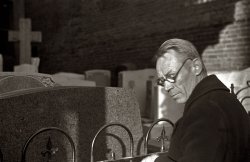
- People's Rapid Transit: 1936
- ... 707 GM gas ) plus underfloor luggage compartments . In 1937 it was replaced by Model 743 which was the same chassis and body . ... Posted by Dave - 07/03/2020 - 12:13pm -
![People's Rapid Transit: 1936 Washington, D.C., 1936. "Bus transportation -- Greyhound Lines motor coach to New York." 4x5 inch glass negative, Harris & Ewing Collection. View full size.
CuppingThat RF tire might need balancing or the front-end could be a little misaligned; should make it to New York though.
Same Location, Different BusBased on the curved bay on the building behind the bus this is the same location as the previous bus image. It appears that the bus in the previous image is still there and just visible behind the foreground bus.
Interurban AllstarsThis is a Yellow Coach Model 719 which was built exclusively for Greyhound . There were 329 built starting in 1936 . It featured an advanced configuration of a rear engine ( 6 cylinder 707 GM gas ) plus underfloor luggage compartments . In 1937 it was replaced by Model 743 which was the same chassis and body . Improvements were a diesel engine and air conditioning . It was a big hit with 1296 built . Yellow Coach went out of business in 1943 , its factory was probably put to good use for the war effort .
[Periods and commas should never be preceded by a space. Right? - Dave]
Yellow Coach didn't actually go out of businessIn 1925, GM bought a controlling interest in the company, which explains the GM engine used in this model. In 1943, GM completely bought out the company and folded it into the GM Truck Division, but continued to build Yellow Coach models under the GM name. For example, the so called "old-look" transit bus brought out by Yellow Coach in 1940 was sold up until 1959, but as a GM model after 1943.
https://en.wikipedia.org/wiki/GM_%22old-look%22_transit_bus
(The Gallery, Cars, Trucks, Buses, D.C., Harris + Ewing)](https://www.shorpy.com/files/images/SHORPY-33575a.thumbnail.jpg)
- Louisiana Noir: 1932
- ... of 1928-1934, although the UT Tower wasn't completed until 1937.
Well, Martha, it's either the State Capitol or the Woolworth ... Posted by Dave - 02/10/2014 - 4:05pm -
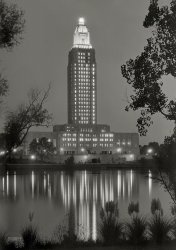
- Vegetable Kingdom: 1939
- ... and Carl D. (1932); they had a sister, Delorise, born in 1937.
["Delorise" -- really? - Dave]
(The Gallery, Agriculture, ... Posted by Dave - 06/15/2018 - 10:55pm -
![Vegetable Kingdom: 1939 September 1939. "Ernest W. Kirk Jr. with his two sons on their farm near Ordway, Colorado. They hold fruits of their farm, coming from their labor, which has placed them in a few months from almost hopeless condition to a family with net worth approaching a thousand dollars." Medium format negative by Dorothea Lange for the Farm Security Administration. View full size.
The value of working hard$1,000 in 1939 works out to a tad over $18,000 according to the BLM inflation calculator.
Really oddMultiple pictures show he has a wife and a young daughter in addition to his two sons. And I believe I found an obit from his oldest son but they are nowhere to be found in the 1940 Census.
PerspectiveMy parents bought their first house for $500 during the 1930s. Dad made the huge sum of $40 a month. $1000 may not be a lot of money today, but it was a sizable sum back then.
High cost of goodiesBack in those days candy bars were a nickel, as was a bottle of pop, six pack was a quarter. When I was sent to the store I sometimes got a penny or two for candy, if I was lucky. We had quite a choice, from licorice cigarettes, licorice chewing tobacco, white candy cigarettes -- lotsa goodies, all for a penny.
The importance of beingIn the 1940 Census our man is listed as Earnest W. Kirk Jr., born in Oklahoma in 1900. In 1925 he married to Ester Adams, born in Oklahoma in 1905. The two boys are Earnest (b. 1928) and Carl D. (1932); they had a sister, Delorise, born in 1937.
["Delorise" -- really? - Dave]
(The Gallery, Agriculture, Dorothea Lange, Kids)](https://www.shorpy.com/files/images/SHORPY-8b22782a1.thumbnail.jpg)
- Bare Beach: 1939
- ... body. This style of stake truck was introduced in 1937 on the same drop-center chassis as Ford cars. Notice how they had to ... Posted by Dave - 07/18/2014 - 2:44pm -
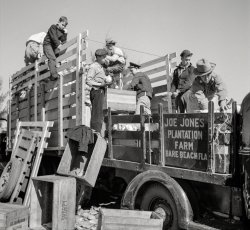
- Featured Player: 1920
- ... was appointed as a member of the Necrology Committee in 1937. He remained a member of the organization the rest of his life.
They ... Posted by Dave - 11/17/2016 - 8:36pm -
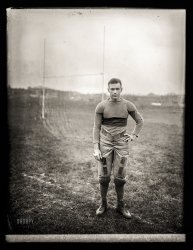
- Day Turkeys: 1925
- ... at a farm in Howard County that's been selling them since 1937. Today's broad-breasted white is a long way from this fellow's colorful ... Posted by Dave - 11/23/2016 - 11:32am -
